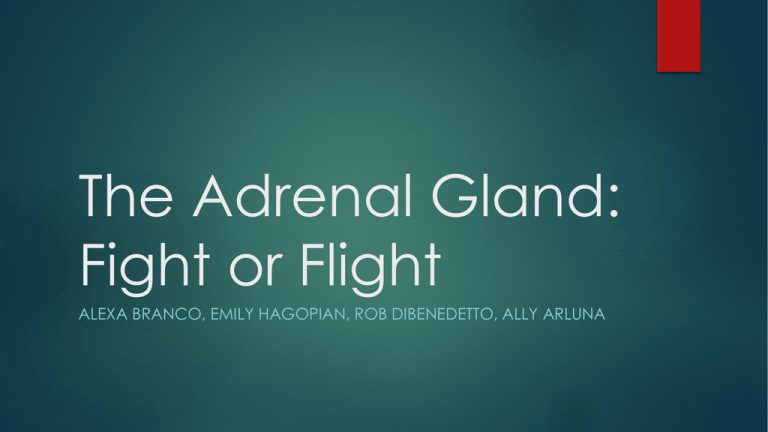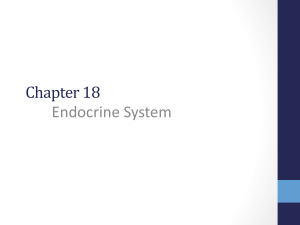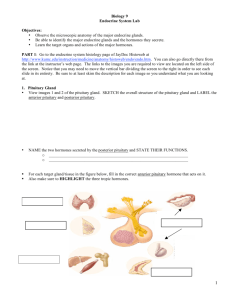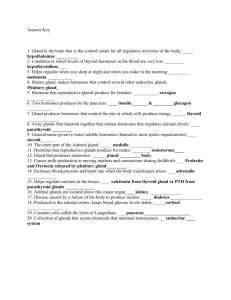The Adrenal Gland: An Inside Look at Our Minds
advertisement

The Adrenal Gland: Fight or Flight ALEXA BRANCO, EMILY HAGOPIAN, ROB DIBENEDETTO, ALLY ARLUNA Location, Location, Location Position: On top of the kidneys 2 parts: Adrenal Medulla Inner part of gland Produces hormones such as adrenaline Adrenal Cortex Outer part of gland Produces hormones such as coritsol Hormones Cortisol Steroid hormone Produced in humans by the zona fasciculata Released in response to stress and low blood glucose The function is to increase blood sugar, to suppress the immune system, and to aid in the metabolism of fat, protein, and carbohydrate Decreases bone formation Aldosterone Steroid hormone Produced by the zona glomerulosa Regulates blood pressure Increases reabsorption of ions and water in the kidneys Hormones (cont.) Adrenaline Also known as Epinephrine Produced in the medulla of the adrenal glands Released into the bloodstream and serve as chemical mediators Also convey the nerve impulses to various organs Key action: increasing the heart rate, increasing blood pressure, expanding air passages of the lungs, etc. Norepinephrine Has the role of a neurotransmitter and a hormone Also referred as a stress hormone The neurotransmitter released from the sympathetic neurons to affect the heart Increase in heart rate, glucose release, and breathing rate It also helps us think clearer by increasing the amount of oxygen going to our brain Diseases related to the Adrenal Glands With adrenal gland (or suprarenal) disorders, your glands make too much or not enough hormones. Causes Genetic mutations Tumors Infections A problem in another gland, such as the pituitary, which helps to regulate the adrenal gland Adverse reaction to medication Addison’s Disease Hypo secretion of the adrenal cortices results from damage to the adrenal cortex this causes the cortex to produce hormone levels that are too low insufficient production of cortisol and aldosterone Causes and Symptoms of Addison’s Disease destruction of the adrenal glands by infection an autoimmune attack an inherited mutation in the ACTH receptor on adrenal cells Symptoms include weakness of the muscles and constant fatigue, loss of appetite leading to weight loss, nausea, vomiting and a fall in blood pressure With hormone, or replacement therapy with glucocorticoids and mineralocorticoids, most people with Addison disease are able to lead a normal life Cushing’s Disease -excessive production of glucocorticoids -cortisol levels are too high -high hormone levels -disfiguration of the body Causes and Symptoms -excessive production of ACTH by the anterior lobe of the pituitary -excessive production by the adrenals themselves (e.g., because of a tumor) -result of glucocorticoid therapy for some other disorder such as -Rheumatoid arthritis or -preventing the rejection of an organ transplant Cure -Removal of tumor -Steroid drugs Fun Facts The adrenal gland is responsible for human’s fight or flight response. The adrenal gland changes in size throughout a person’s life. Prior to birth, the glands are the size of the kidneys, but shrink once the baby is born. When a person reaches old age, the glands are so small they can hardly be seen. Concept Check Questions What are the two parts of the adrenal gland? What are the functions of each? Adrenal Medulla- produces hormones such as adrenaline Adrenal Cortex- produces hormones such as cortisol What is another name for epinephrine and what action does this hormone perform? Adrenaline- Increases heart rate, increases blood pressure, expands air passages of the lungs Name two adrenal gland hormones. Give a similarity and a difference between the two. Cortisol- produced in zona fasciculata Aldosterone- produced in zona glomerulosa Both are steroid hormones Works Cited "Aldosterone." You & Your Hormones. Society for Endocrinology, n.d. Web. 13 Mar. 2015. <http://www.yourhormones.info/hormones/aldosterone.aspx>. Sargis, Robert M. "An Overview of the Adrenal Glands." Endocrine Web. Vertical Health, n.d. Web. 13 Mar. 2015. <http://www.endocrineweb.com/endocrinology/overview-adrenalglands>. Shmaefsky, Brian R. Applied Anatomy & Physiology. St. Paul: Paradigm, 2007. Print.









